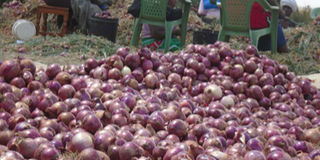Ask your Agronomist: Get best onion bulb and weight by following this fertiliser regime

Farm employees prepare harvested bulb onions. Onions generally prefer a nitrate form of nitrogen as opposed to ammonium forms. PHOTO | NATION MEDIA GROUP
What you need to know:
- It is essential to time the applications of nutrients as close as possible to the rooting zone in frequently and readily available forms.
- Nutrient removal figures show that nitrogen and potassium are the nutrients needed in greatest quantities in onion crops.
- Fertiliser application for onion should therefore start by first week after transplanting, with an NPK regime for establishment of the crop.
Q: I am an onion farmer in Taveta and want to know the best fertilizer to use for growing onions in this region.
In onion production, the first thing you have to know is market requirements and manipulate the production practice to produce the desired quality of onion.
Planting density and fertilisation are critical in determining the size, weight and general quality of Onion bulbs produced.
Onions have a relatively low nutrient uptake efficiency due to their shallow root system, characterised by thick roots with very few and short hairs.
Therefore it is critical to implement a fertiliser programme adapted to those conditions in order to help to achieve optimum yields.
It is essential to time the applications of nutrients as close as possible to the rooting zone in frequently and readily available forms.
Major Nutrient Removal
Application of fertilizers that supply a balanced nutrient supply for onion, giving both primary secondary and micro-nutrients is critical for high yields and quality of onions.
Nutrient removal figures show that nitrogen and potassium are the nutrients needed in greatest quantities in onion crops.
They are fundamental for achieving high marketable yields. However, it is important not to overapply nitrogen, particularly in bulb onions, as this can delay maturity, soften bulbs and lead to storage rots.
In similar fashion to nitrogen, most phosphorus is required early on in the plant’s development to ensure good root growth and to boost establishment.
Potassium is particularly important where high N-rates have been applied to help maintain yield by increasing dry matter and sugar accumulation in the bulb (better bulb size and weight).
Fertilisation Regime
Fertiliser application for onion should therefore start by first week after transplanting, with an NPK regime for establishment of the crop.
40% of nitrogen and potassium as well as Calcium requirements should then be applied by the third and fourth week during the first top-dress.
The second top-dressing should then be done at the bulbing stage, supplying the rest of the nutrient needs. Calcium and boron are critical in ensuring a longer shelf life and preventing rots in the bulbs.
Onions prefer a nitrate form of nitrogen as opposed to ammonium forms, and therefore more of Nitrate N source fertilizers such as in YaraMila Winner and Nitrabor will give better results – better bulb size and weight.
Vitalis Wafula, Agronomist East Africa Regional, Yara




